Austrian rocket mail systems projects
It should be noted that Austria does not belong to the primacy in the creation of the so-called. rocket mail. This version of the use of missiles was first proposed by the British. The garrisons and government agencies of Great Britain who worked on the islands of Polynesia, at the end of the 19th century, adapted the Congrive combat rocket to transport mail. However, the flight performance of such a means of mail delivery left much to be desired. Insufficient accuracy could lead to a miss past the island and loss of correspondence. If the rocket fell to the ground, there was a risk of the most serious damage to the cargo. As a result, Congrive’s mail missiles were not used for too long, and then returned to more familiar transport.
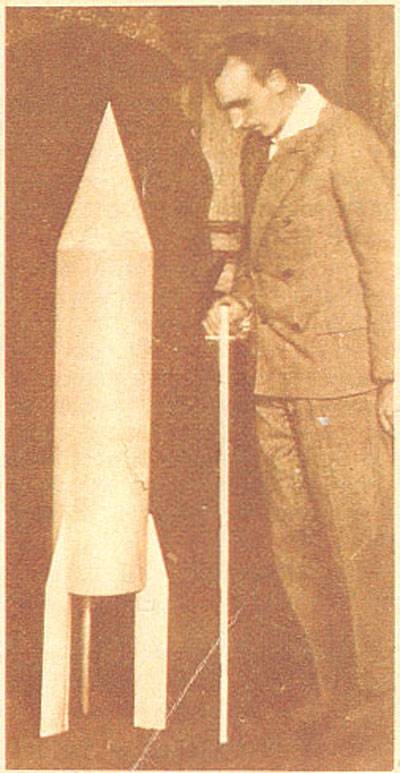
Frederick Schmidl and his mail rocket. Photo Wirtschaft.graz.at
At the level of theory
Apparently, the Austrian experts knew about the original ideas of the British, but until a certain time did not show much interest in them. The situation began to change only in the late twenties, when the Austrian scientist Franz Heft, dealing with the problems of the development of rocket technology, began to consider new options for its use.
In 1927-28, F. Heft read several lectures in which he proposed and theoretically substantiated the possibility of using unguided missiles in the transportation of small-size mail items — letters, wrappers, and small parcels. Moreover, a theoretical version of the proposed draft version of the rocket with the working name PH-IV was proposed. Unfortunately, very little is known about this project. History retained only common features of the proposed rocket.
According to the available data, F. Heft proposed to build a rocket with several stages, the number of which, however, is unknown. Several steps should have been given to the placement of the engines, which work consistently and are responsible for bringing them to the calculated trajectory. The upper stage was a cargo compartment and it was necessary to put the payload in the form of mail. The cargo stage was supposed to have the means of safely returning to the ground in the form of brake parachutes.
As far as we know, Franz Heft did not develop his project and turn theoretical calculations into a real structure. On the other hand, there appeared a justification for the possibility of using rocket technology in one of the most important sectors, which could not fail to attract the attention of specialists in several directions at once. However, such interest was limited. Despite curiosity and many positive reviews, F. Heft’s proposal did not interest the officials.
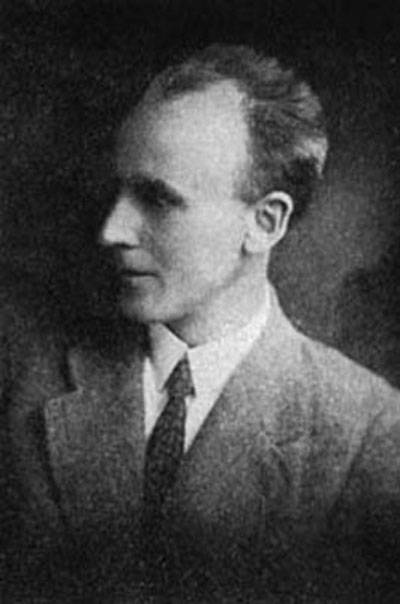
Friedrich Schmidl - inventor of the first Austrian rocket mail system, brought to operation. Photo Wirtschaft.graz.at
From experiments to exploitation
The project PH-IV by the authorship of F. Hefta did not go unnoticed. Among other specialists, he was interested in a young engineer Friedrich Schmidl. Even in his youth, before entering the technical university, he began to engage in rocket technology and even built his own small-sized products. The original proposal for the use of missiles in the postal area attracted his attention. Soon F. Schmidl conducted the first real experiments in a new field.
Already in 1928, the designer built and tested the first version of his mail rocket. According to some sources, the first test launches conducted using the weight correspondence simulator were not always successful. However, at the same time, the final design was carried out, and as a result, F. Schmidl was able to get the optimal variant of the rocket that meets the requirements for it. At such work took several years. It should be noted that such terms of development and refinement of the project were associated not only with its complexity. In parallel with the rocket mail, F. Schmidl developed rockets for meteorological research, aerial photography, etc.
By the beginning of 1931, F. Schmidl’s rocket mail was ready for the first launch with a real payload. The launches were planned to be carried out from the missile position on the slope of Sjökl mountain. It had launchers and buildings to work with missiles. From the existing position it was possible to send missiles to several nearby cities. It was assumed that the fallen rocket would be found by local postmen, who then had to process and deliver correspondence to the recipients.
Schmidl’s mail rocket had a fairly simple design. She received a cylindrical body with a conical head fairing with a total length of about 1 m. In the tail part of the body there were three flat stabilizers protruding behind the bottom with a nozzle. Most of the rocket was occupied by a solid-fuel engine. In the main compartment there was room for several kilograms of cargo. A parachute for a soft landing and the simplest radio control system responsible for its release were also placed there.
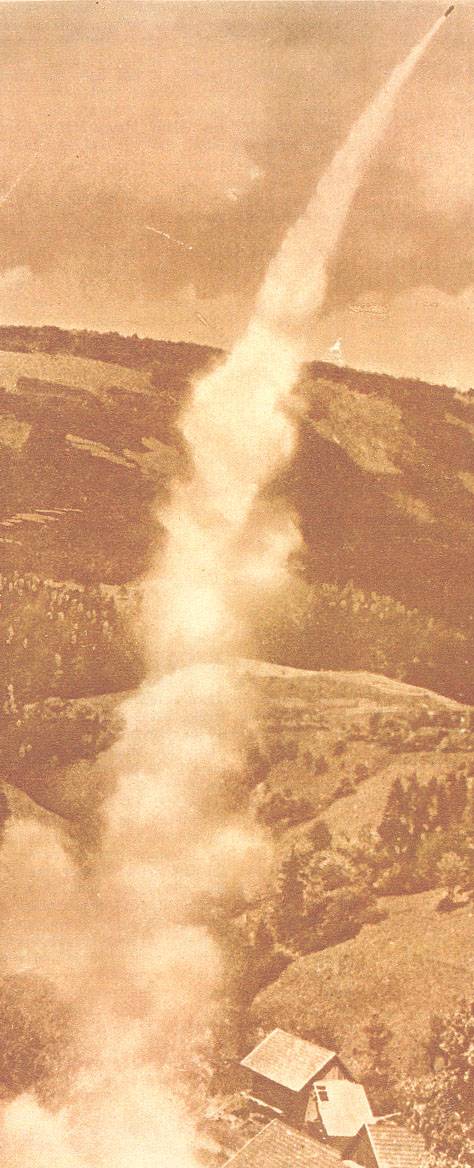
Mail rocket in flight. Photo Wirtschaft.graz.at
2 February 1931, the year F. Schmidl first sent a rocket into flight with mail on board. More than a hundred letters were sent from the Szökl mountain to the town of St.-Radegund-by-Graz. Letters were sent in ordinary envelopes with Austrian stamps. However, at the last, the inventor wrote “Raketen Flugpost. Schmiedl ”(“ Rocket Mail, Schmidl ”) and put the launch date. Now such envelopes and stamps are of particular interest to philatelists.
Upon command from the control panel, the engine ignited and the rocket headed towards the landing area. At the right moment, over the radio channel, the team was sent to open a parachute. The rocket landed with almost no damage, and correspondence was extracted from it, which then went to the addresses. The flight distance was only a few kilometers, but this launch clearly showed the fundamental possibility of using missiles to quickly transport mail. The further development of rocket technology as a whole made it possible to obtain long ranges of flight, under which the mail rocket could have advantages over other transport.
In the same year 1931, several new missile launches were carried out with mail along the same route. The rocket mail was liked by the locals, and besides, it interested people from other cities, regions and even countries. Letters were specially handed over to F. Schmidl to fly on a rocket and turn into an interesting souvenir. It is worth noting that such interest contributed to the further development of the project. Sending letters by rocket mail, of course, was not free, and there was enough customer fees to finance the work. From a certain time, the project began to support philatelic organizations interested in the emergence of new collection materials.
To the delight of philatelists, the inventor eventually stopped manually marking existing brands and issued his own payment marks. They had the shape of a triangle, in which the eagle (symbol of Austria) and a flying rocket were depicted. There were also the inscription Raketenflugpost in Oesterreich and the nominal mark. Stamps of different cost differed from each other in the color of the paper and in different shades of blue paint.
Perspective development
From 1931, F. Schmidl’s rocket post transported only letters and only along the route “Sjökl - St. Radegund”. It was obvious that such features of operation do not allow to realize the full potential of the original idea. In this regard, the inventor, continuing the operation of the existing missile "communication line", began to work out new ones.
According to some information, shortly after the first successful tests, F. Schmidl began to work on the appearance of a promising mail rocket with enhanced characteristics. Such a product had to fly further, take on board more cargo and fall into a given area with greater accuracy. Such a rocket might need new control systems, autonomous or remote. An improved rocket could find practical application and become a profitable alternative to other transport. With a reasonable ratio of range and capacity, she was able to compete, for example, with cars.
A study was also conducted on the creation of a new postal system across the state. Across Austria, it was proposed to build rocket post offices with launchers and other necessary equipment. Moreover, F. Schmidl planned to open the world's first international line of rocket mail. It was supposed to connect Ljubljana (Slovenia), Graz (Austria) and Basel (Switzerland).
It should be recalled that by that time Austria and the neighboring countries already had highly developed mail systems. The massive introduction and use of postal missiles could have a serious impact on their condition and capabilities. However, one should have expected some specific problems directly related to the imperfection of the rocket technology of that time.
Rocket Laws
The activity of F. Schmid’s rocket mail continued until the 1934-35 of the year. During this period, the designer-enthusiast faced new problems of a legal nature, and therefore was forced to stop working. The rocket mail consistently struck two serious blows that did not allow it to continue its activities as they were.
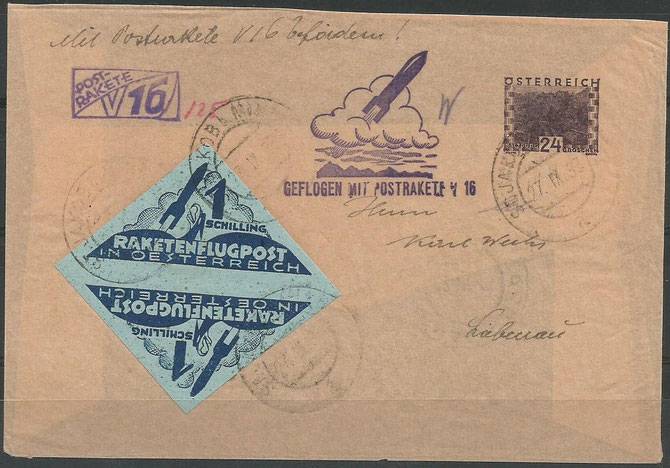
The envelope that visited aboard the Schmidl rocket. Photo Luna-spacestamps.de
At first, claims against F. Schmid's company were put forward by the Austrian state post. The private company of the inventor produced its own brands, and it was considered a violation of the laws. While the inventor was trying to deal with such a problem, lawmakers created a new one. Civilians and commercial organizations are prohibited from working with explosives, including solid rocket fuel. To avoid a very harsh punishment, F. Schmidl and his colleagues had to destroy all fuel supplies, as a result of which the assembly of new missiles was impossible.
In the current situation, the activities of Raketenflugpost in Oesterreich could continue only in the structure of the state mail and with the participation of any defense enterprise having the right to work with rocket fuel. However, the post office was not interested in the development of F. Schmidl and continued to use existing vehicles.
On this, the story of the Austrian missile mail actually ended. Friedrich Schmidl continued to work in the field of missiles, but now he was forced to confine himself to theoretical research. Also, from a certain time, he was engaged in engineering and technology in other areas, including road transport, shipbuilding, Aviation etc.
End of story
After 1935, there was no hope of resuming work. And soon the last and fatal blow was struck on the original projects. In March, 1938, Hitler’s Germany occupied Austria. Fearing that his achievements would fall into the hands of the invaders and find application in the military sphere, F. Schmidl was forced to destroy all the documentation he had on rocket engineering projects. Together with other papers, the calculations and drawings of postal rockets, as well as the remaining equipment for their operation, were destroyed.
A few years later, F. Schmidl was sent to the front as a military engineer. After World War II, he returned home and continued to work in the design field. It is curious that his pre-war developments were not forgotten. So, at the end of the forties, the inventor was invited to the United States for further work on rocket mail. However, he did not accept the invitation and stayed at home. Moreover, he almost completely abandoned any research and projects in the field of missiles.
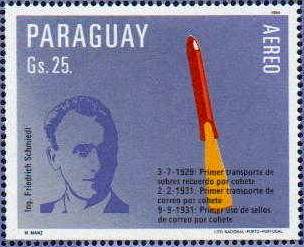
Paraguayan brand 1984, dedicated to the Austrian inventor F. Schmidl. Photo of Wikimedia Commons
Friedrich Schmidl died 11 September 1994 of the year. After his death, the Friedrich Schmiedl Foundation was founded in Graz, the purpose of which was to promote the development of communications in the region. With the direct support of this fund, several important infrastructure projects of various kinds were implemented. However, they had no relation to the rocket mail, developed by F. Schmidl.
***
Austrian rocket mail projects proposed in the twenties and thirties of the last century, could not interest the official structures and developed exclusively by the forces of enthusiasts. It may give the impression that the reason for this was the inertia and retrograde of the responsible persons who did not want to master the new technology and were holding onto the available transport with all their might. Nevertheless, the rejection of the mass use of mailing rockets had very real reasons.
In fact, the only advantage of a postal rocket over traditional vehicles, regardless of its flight performance, is the speed of delivery. Due to the high-speed flight on a ballistic trajectory, it is able to get to the right place for the minimum time. However, a number of characteristic flaws are also connected with this, many of which in the times of F. Schmidl were fundamentally intractable.
First of all, mail delivery by rocket is quite expensive. If, however, to simplify and reduce the price of such transport, then its characteristics may suffer. The second significant problem of rockets of that time is the lack of full-fledged control systems and, as a result, low firing accuracy and unreliability of the main devices. As a result, the rocket could not only drop by parachute into the field, but also simply fall onto the roof of the venerable burgher. As a result, lack of reliability was combined with danger to the public.
At the beginning of the 1930s, F. Schmidl and his colleagues simply could not rid their invention of such shortcomings. Because of this, their rocket system had no real chance of becoming a full-fledged competitor to traditional ground mail. Later, after a few decades, the necessary technologies and devices were created, but by this time the idea of rocket mail had actually been forgotten. Now about the inventions of Franz Heft, Friedrich Schmidl and their colleagues are reminded only of individual written sources, as well as the preserved envelopes and special stamps that philatelists hunt with great interest.
On the materials of the sites:
http://wirtschaft.graz.at/
http://philatel2.com/
http://post-marka.ru/
http://filatelist.narod.ru/
http://austria-lexikon.at
https://luna-spacestamps.de/
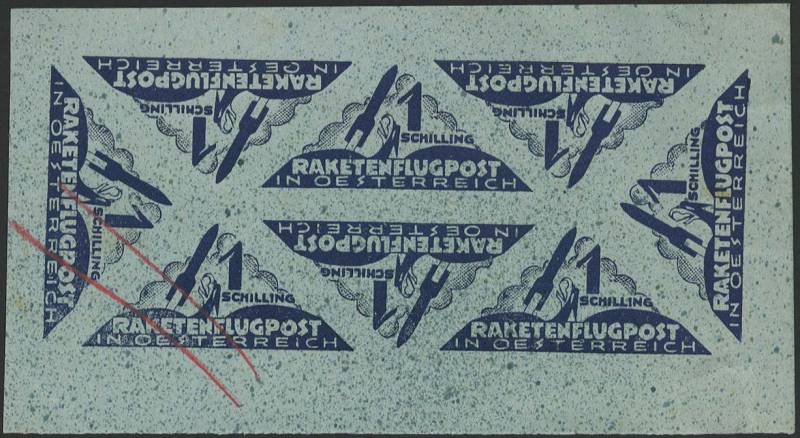
Information